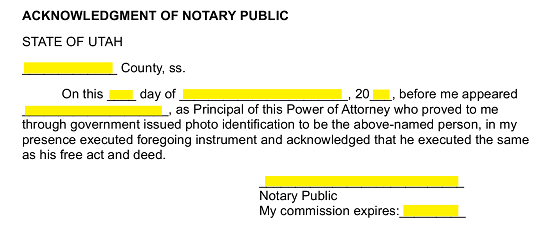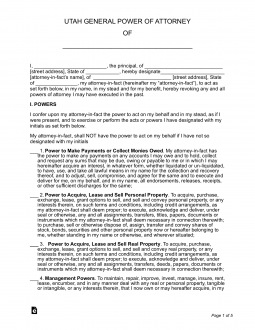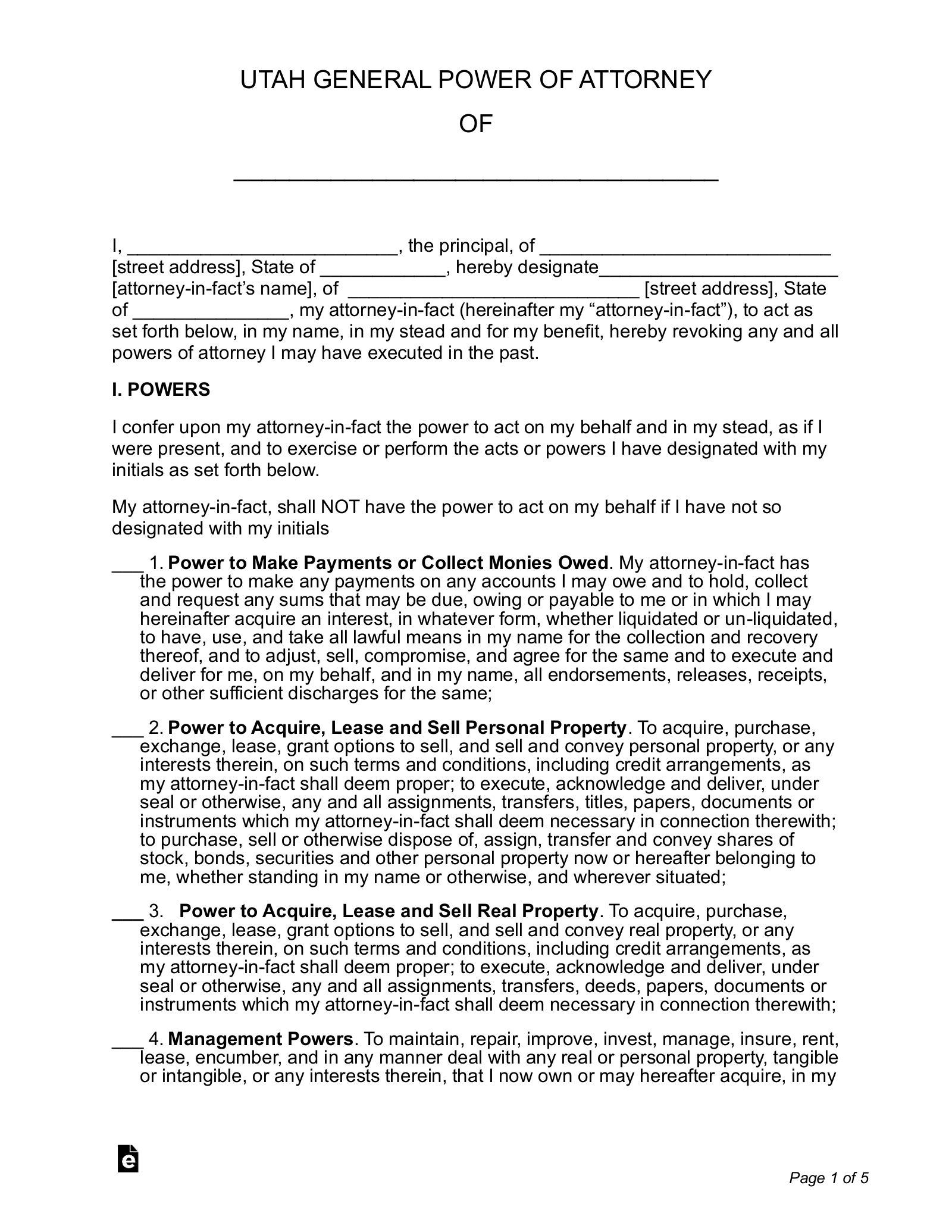Updated August 09, 2023
A Utah General (Financial) Power of Attorney Form should be used when designating an agent to represent your interests in financial transactions and other affairs. Since your representative can have access to your property and assets as well as make decisions regarding such matters, think about who you can trust to take on that role. Why is this different from a durable power of attorney? Because the appointment made by this document terminates automatically if the principal can no longer make his or her own decisions. For instance, if the principal suffers a medical event that renders him or her unconscious or unintelligible, the agent’s ability to wield principal power will cease automatically upon a physician’s diagnosis. If you are looking for something that continues to be effective after your potential incapacity, you should look at the durable form instead.
Laws
- Statutes – Uniform Power of Attorney Act
- Authority (U.C.A. 1953 § 75-9-201) – An agent under a power of attorney may act on behalf of the principal and exercise broad authority as granted by the agreement.
- Signing Requirements (U.C.A. 1953 § 75-9-105) – Notary Public.
How to Write
Download: PDF, MS Word, OpenDocument
1 – State The Identity Of The Granting Principal And The Receiving Agent
The title of this document, at the top of the first page, contains an empty line. Make sure the Full and Legal Name of the Principal is presented on this blank line. The Principal will be the Grantor of Powers in this document.  The Name of the Principal will also need to re-appear on the first blank space in the first paragraph. Make sure you transcribe it from the Title. The way it is presented in these two areas must be identical to one another.
The Name of the Principal will also need to re-appear on the first blank space in the first paragraph. Make sure you transcribe it from the Title. The way it is presented in these two areas must be identical to one another.  In addition to naming this entity, we will also need to identify where the Principal lives. Enter his or her Street Address on the second empty line in this paragraph, then complete the Principal report by filling in the Principal’s State on the third blank space.
In addition to naming this entity, we will also need to identify where the Principal lives. Enter his or her Street Address on the second empty line in this paragraph, then complete the Principal report by filling in the Principal’s State on the third blank space.  The next few areas in this paragraph concentrate on the Attorney-in-Fact. This is the entity that will be able to use the Principal’s Authority to effect Principal Affairs. This will be defined later. For now, use the blank space after the word “Designate” to record the Attorney-in-Fact’s Name.
The next few areas in this paragraph concentrate on the Attorney-in-Fact. This is the entity that will be able to use the Principal’s Authority to effect Principal Affairs. This will be defined later. For now, use the blank space after the word “Designate” to record the Attorney-in-Fact’s Name.  The next two blank spaces should be used to present the Street Address and the State of the Attorney-in-Fact’s Address. Make sure each component in its appropriate area.
The next two blank spaces should be used to present the Street Address and the State of the Attorney-in-Fact’s Address. Make sure each component in its appropriate area.
2 – The Principal Approved Powers Must Be Determined And Delegated In The First Article
The Principal Powers that will be granted to the Attorney-in-Fact will be dependent solely on the Principal’s approval. A list of sixteen different Principal Powers has been placed in Article “I. Powers.” The Principal must read through these various Power Types. Any of these Power Type descriptions that have been initialed by the Principal will be included in the Principal Powers the Attorney-in-Fact may wield while each one that has not been initialed will be excluded from the Attorney-in-Fact’s Principal Powers.
The first type of Principal Powers that can be granted to the Attorney-in-Fact is defined as the “Power To Make Payments Or Collect Monies Owed.” A concise description of what the Attorney-in-Fact can do in the Principal’s Name using these Powers is supplied in the paragraph. If the Principal wishes the Attorney-in-Fact to have the right to carry out the defined actions, then he or she should initial the blank space just before the number “1.” The second list item defines itself with the label “2. Power To Acquire, Lease And Sell Personal Property” and will contain the language required to allow the Attorney-in-Fact the right to use the Principal’s Name to perform actions such as selling or leasing the Principal’s Personal Property or acquiring more Principal Property using the Principal’s Name. The Principal must initial the corresponding blank space to grant this Power to the Attorney-in-Fact.
The second list item defines itself with the label “2. Power To Acquire, Lease And Sell Personal Property” and will contain the language required to allow the Attorney-in-Fact the right to use the Principal’s Name to perform actions such as selling or leasing the Principal’s Personal Property or acquiring more Principal Property using the Principal’s Name. The Principal must initial the corresponding blank space to grant this Power to the Attorney-in-Fact. The Principal can give the Attorney-in-Fact the Authority and “Power To Acquire, Lease And Sell Real Property” by initialing the blank space just before the number 3. The Principal can withhold granting this Power to the Agent by simply not initialing this item.
The Principal can give the Attorney-in-Fact the Authority and “Power To Acquire, Lease And Sell Real Property” by initialing the blank space just before the number 3. The Principal can withhold granting this Power to the Agent by simply not initialing this item. The Principal Authority used to manage his or her Property can be delivered to the Attorney-in-Fact when the Principal initials the line corresponding to the paragraph labeled “4. Management Powers.” If this type of Principal Authority should not be included in the Attorney-in-Fact’s Principal Powers, then he or she should refrain from initialing this blank line.
The Principal Authority used to manage his or her Property can be delivered to the Attorney-in-Fact when the Principal initials the line corresponding to the paragraph labeled “4. Management Powers.” If this type of Principal Authority should not be included in the Attorney-in-Fact’s Principal Powers, then he or she should refrain from initialing this blank line. If the Attorney-in-Fact should be granted the Principal Power to perform Banking functions with Financial Institutions on behalf of the Principal, the Power Type designated as “5. Banking Powers” should be initialed by the Principal.
If the Attorney-in-Fact should be granted the Principal Power to perform Banking functions with Financial Institutions on behalf of the Principal, the Power Type designated as “5. Banking Powers” should be initialed by the Principal. The Principal’s Name and Authority may be utilized to make decisions and conduct actions with vehicles (i.e. cars, motor boats, etc.) by the Attorney-in-Fact when the Principal initials the “6. Motor Vehicles” paragraph.
The Principal’s Name and Authority may be utilized to make decisions and conduct actions with vehicles (i.e. cars, motor boats, etc.) by the Attorney-in-Fact when the Principal initials the “6. Motor Vehicles” paragraph. The Attorney-in-Fact will have the Principal Power to represent the Principal in the Principal’s Tax affairs through the language supplied in “7. Tax Powers.” The Principal can grant the Agent the right to engage in all the actions defined in this item if he or she initials the corresponding blank line.
The Attorney-in-Fact will have the Principal Power to represent the Principal in the Principal’s Tax affairs through the language supplied in “7. Tax Powers.” The Principal can grant the Agent the right to engage in all the actions defined in this item if he or she initials the corresponding blank line. If the Principal intends to give the Attorney-in-Fact the right to exercise Principal Authority to access Safe Deposit Boxes and control their contents, the blank line preceding “8. Safe-Deposit Boxes” will have to be initialed by the Principal.
If the Principal intends to give the Attorney-in-Fact the right to exercise Principal Authority to access Safe Deposit Boxes and control their contents, the blank line preceding “8. Safe-Deposit Boxes” will have to be initialed by the Principal. If the Principal intends to give the Attorney-in-Fact “Gift Making Powers” then he or she should initial the ninth Power Type on this list (“9. Gift Making Powers”).
If the Principal intends to give the Attorney-in-Fact “Gift Making Powers” then he or she should initial the ninth Power Type on this list (“9. Gift Making Powers”). The same “Lending And Borrowing” Powers the Principal wields can be given to the Attorney-in-Fact through this document when the blank line in the tenth Power Type is initialed by the Principal.
The same “Lending And Borrowing” Powers the Principal wields can be given to the Attorney-in-Fact through this document when the blank line in the tenth Power Type is initialed by the Principal. The Principal’s “Contracts” can also be placed within the scope of the Attorney-in-Fact’s Principal Power, allowing the Attorney-in-Fact to negotiate and uphold contracts on behalf of the Principal. If the Principal intends to grant this Power to the Attorney-in-Fact he or she should initial the blank line that precedes “11. Contracts.”
The Principal’s “Contracts” can also be placed within the scope of the Attorney-in-Fact’s Principal Power, allowing the Attorney-in-Fact to negotiate and uphold contracts on behalf of the Principal. If the Principal intends to grant this Power to the Attorney-in-Fact he or she should initial the blank line that precedes “11. Contracts.” ![]() “Health Care” matters will be discussed in the wording for the twelfth Power Type. If the Attorney-in-Fact should have the Principal Authority to make decisions regarding Health Care Facilities and the Principal’s Admission and Discharge along with the right to access the Principal’s Medical Records then, the Principal should initial the blank space just before the number “12.”
“Health Care” matters will be discussed in the wording for the twelfth Power Type. If the Attorney-in-Fact should have the Principal Authority to make decisions regarding Health Care Facilities and the Principal’s Admission and Discharge along with the right to access the Principal’s Medical Records then, the Principal should initial the blank space just before the number “12.” In addition to Health Care Powers, the Principal can also name the Agent or Attorney-in-Fact here with the same representative Powers defined in the Health Insurance Portability And Accountability Act of 1996 by initialing the space associated with “13. HIPAA.”
In addition to Health Care Powers, the Principal can also name the Agent or Attorney-in-Fact here with the same representative Powers defined in the Health Insurance Portability And Accountability Act of 1996 by initialing the space associated with “13. HIPAA.” If the Attorney-in-Fact named above is to have the Principal Authority to arrange for who shall provide the Principal with professional services and arrange for payments of such on behalf of the Principal, then the Principal will have to initial “14. Power To Hire And Pay For Services.”
If the Attorney-in-Fact named above is to have the Principal Authority to arrange for who shall provide the Principal with professional services and arrange for payments of such on behalf of the Principal, then the Principal will have to initial “14. Power To Hire And Pay For Services.” The Principal Power to deliver Reimbursement Of Attorney-in-Fact can be left to the discretion of the Attorney-in-Fact when included in the Principal Powers assigned to him or her. This will require the Principal to initial the Power Type labeled “15. Reimbursement Of Attorney-in-Fat.”
The Principal Power to deliver Reimbursement Of Attorney-in-Fact can be left to the discretion of the Attorney-in-Fact when included in the Principal Powers assigned to him or her. This will require the Principal to initial the Power Type labeled “15. Reimbursement Of Attorney-in-Fat.”![]() The Principal Power to use the courts to enforce this document may be granted to the Attorney-in-Fact if the Principal initials “16. Power To Sue Third Parties Who Fail To Act Pursuant To Power Of Attorney”
The Principal Power to use the courts to enforce this document may be granted to the Attorney-in-Fact if the Principal initials “16. Power To Sue Third Parties Who Fail To Act Pursuant To Power Of Attorney” If there are additional Powers the Principal would like to assign the Attorney-in-Fact, but they have not been included in the above classifications, they may be recorded in the last category, “17. Other.” Once the additional Powers have been adequately described for the use of this document, the Principal should initial the bank line to the left of it.
If there are additional Powers the Principal would like to assign the Attorney-in-Fact, but they have not been included in the above classifications, they may be recorded in the last category, “17. Other.” Once the additional Powers have been adequately described for the use of this document, the Principal should initial the bank line to the left of it.
3 – When These Powers Start And Terminate Is A Required Definition For This Paperwork
The Attorney-in-Fact and all other interested entities will need to know when he or she can use the Principal Powers listed to represent the Principal’s wishes. This means the Start Date must be defined in this template with the direct approval of the Principal. In the first area in “III. Effective Date And Termination,” this task will be accomplished.
If the Principal intends for the Principal Powers here to have the same Start Date as his or her Date of Signature to this appointment, then the first statement (“Upon The Date Of This Document…”) must be initialed by the Principal. Otherwise, he or she can initial the second statement and name a Start Date by entering the desired Calendar Date on the blank spaces provided in this statement.  The second area in “III. Effective Date And Termination” will supply a defined area where the Termination of the Principal Powers here can be defined and approved by the Principal. The three last statements in this section will provide three choices the Principal may choose from. The Principal can name the Termination Date using the first of these choices then initialing the blank line that precedes it. The second option allows the Principal Powers here to exist unless the Principal has revoked it, while the third will set their Termination to occur if or when the Principal is incapacitated. The Principal can only initial one of these options to define the Termination Date.
The second area in “III. Effective Date And Termination” will supply a defined area where the Termination of the Principal Powers here can be defined and approved by the Principal. The three last statements in this section will provide three choices the Principal may choose from. The Principal can name the Termination Date using the first of these choices then initialing the blank line that precedes it. The second option allows the Principal Powers here to exist unless the Principal has revoked it, while the third will set their Termination to occur if or when the Principal is incapacitated. The Principal can only initial one of these options to define the Termination Date.
4 – The Principal’s Signature Must Be Accompanied By The Agents’ And Notary Public Aknowledgment
Article “IV. Third Party Reliance” designates a specific area where the Principal’s Dated Signature may be supplied. The Principal will need to locate the last statement here, then supply the Date he or she is signing it using the blank spaces after the words “I Have On This…” As soon as the Principal enters the Signature Date above, he or she must sign his or her Name on the “Principal’s Signature”
As soon as the Principal enters the Signature Date above, he or she must sign his or her Name on the “Principal’s Signature” The Principal must also print his or her Name on the line labeled as “Principal’s Printed Name.”
The Principal must also print his or her Name on the line labeled as “Principal’s Printed Name.” The next area, “Acceptance Of Appointment,” shall call for the attention of the Attorney-in-Fact. First, enter the Name of the Attorney-in-Fact on the blank space presented in the statement. The Attorney-in-Fact must read this statement, then, if he or she agrees with it, Sign and Print his or her Name on the lines just below “Attorney-in-Fact’s Signature” and “Attorney-in-Fact’s Printed Name.”
The next area, “Acceptance Of Appointment,” shall call for the attention of the Attorney-in-Fact. First, enter the Name of the Attorney-in-Fact on the blank space presented in the statement. The Attorney-in-Fact must read this statement, then, if he or she agrees with it, Sign and Print his or her Name on the lines just below “Attorney-in-Fact’s Signature” and “Attorney-in-Fact’s Printed Name.” Finally, once all these parties have signed this document, it should be turned over to the Notary Public in attendance so that it may be properly notarized.
Finally, once all these parties have signed this document, it should be turned over to the Notary Public in attendance so that it may be properly notarized.


